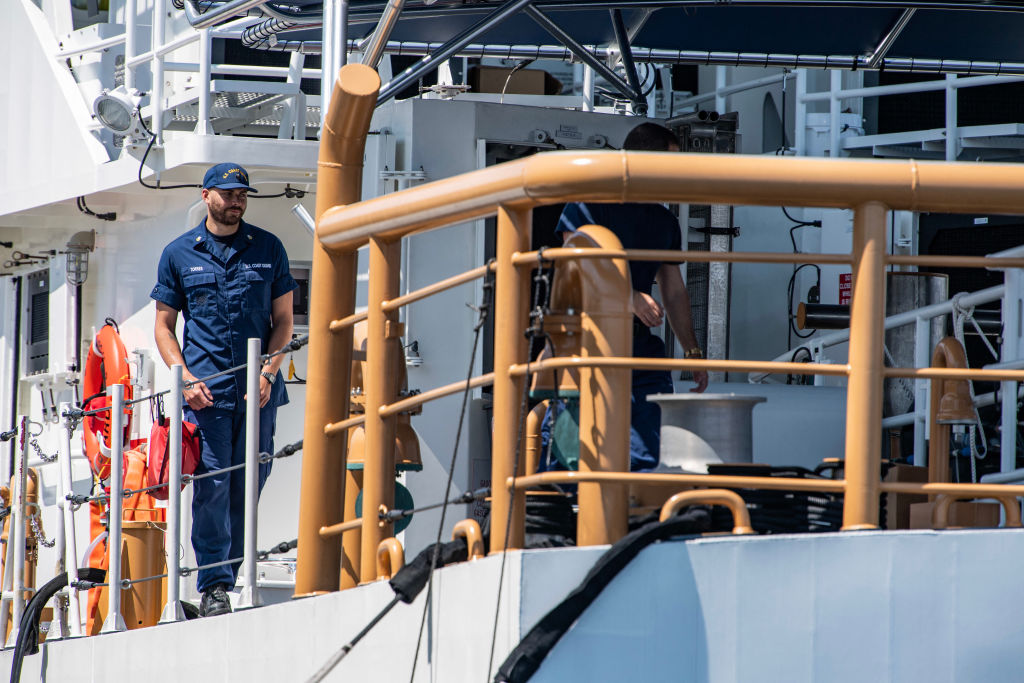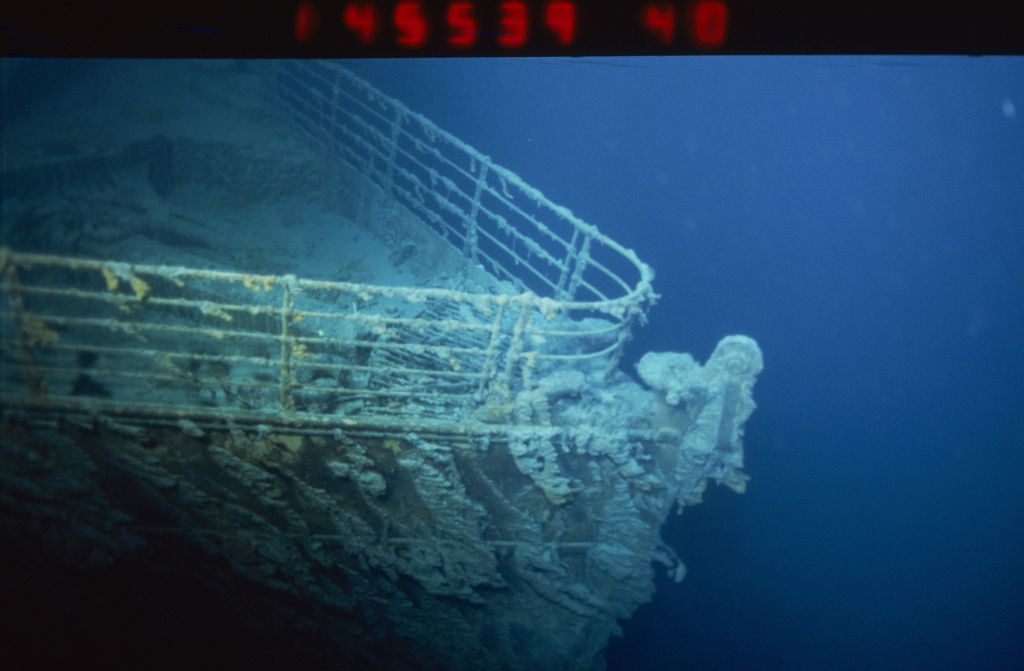The search for the missing Titan vessel has ended after officials said the sub suffered a “catastrophic implosion,” and that the five people onboard are believed to have died, the U.S. Coast Guard (USCG) said during a Thursday afternoon press conference.
“The debris is consistent with a catastrophic implosion of the vessel,” said Rear Admiral John Mauger. Officials said that the location of the debris field was found 1600 feet from the wreck of the Titanic and matched “the location of last communication” of the submersible. The time of the implosion has not yet been determined.
“On behalf of the United States Coast Guard and the entire unified command, I offer my deepest condolences to the families,” Mauger added.
Five major pieces of debris, including the nose cone and pressure hull, were identified as the remains of the submersible, officials added. Officials said they are mapping out the debris field and a timeline of what happened.
Prior to the press conference, OceanGate Expeditions, the company that operated the Titan, released a statement on Thursday saying that they believe all five passengers on the submersible had been “lost.”
“These men were true explorers who shared a distinct spirit of adventure, and a deep passion for exploring and protecting the world’s oceans,” the statement said . “Our hearts are with these five souls and every member of their families during this tragic time. We grieve the loss of life and joy they brought to everyone they knew.”
Search crews announced they had discovered the “debris field” in the North Atlantic using a remotely operated vehicle (ROV) in an area near the Titanic earlier Thursday.
The search and rescue effort
Four countries—Canada, France, England, and the United States—were working together on the search for the Titan, using at least two ROVs that could travel to the seafloor. The search for the Titan, which went missing after the crew lost contact one hour and 45 minutes into its dive early on Sunday, spanned an area twice the size of Connecticut, Captain Jamie Frederick of the USCG said during a press conference early Thursday. The subsurface search was two and half miles deep, reaching the ocean floor.
Rescuers had raced against the clock for days, believing that the the five aboard the vessel could be running out of the 96 hours of oxygen they had onboard that would have run out by Thursday morning,
Noises detected near the Titanic wreckage site on Tuesday had initially raised hopes of finding the missing submersible containing five passengers, the USCG told reporters Wednesday.
The USCG said during Thursday afternoon’s press conference that they used sonar buoys to try to identify any catastrophic failures, but did not hear any during the 72-hour search. “There doesn’t appear to be any connection between the noises and the location on the seafloor,” Rear Adm Mauger said.
“The size of the debris field is consistent with that implosion in the water column,” Mauger added.
Mauger also called the site “an incredibly unforgiving environment,” and did not confirm whether any bodies would be able to be identified. There are currently nine vessels on scene, though those vessels will later be demobilized over the next 24 hours. Underwater robots will remain on scene to gather more information.

Safety warning signs
OceanGate, a privately-owned company, provides diving tours of the famous shipwreck using submersibles that can carry up to five people. The company was warned of potential safety issues with the submersible in 2018, when David Lochridge, OceanGate’s director of marine operations, provided a report detailing potentially dangerous outcomes if the Titan vessel traveled too far deep into the ocean, according to court documents. In the court filing, Lochridge argued that he was wrongfully terminated due to his safety warnings.
A group of industry members warned the company again two months later, when over 30 oceanographers, explorers, and prominent members of the field wrote a letter to OceanGate’s CEO, Stockton Rush, warning that the company’s decision to opt out of traditional safety assessments and classification systems could lead to outcomes “ranging from minor to catastrophic.”
Read More: A Titanic Tourist Submersible Is Missing. Here’s How That Differs From a Submarine
In a blog post on its website, OceanGate explained why it opted out of traditional safety classing by independent groups like American Bureau of Shipping (ABS), DNV/GL, Lloyd’s Register, and others.
“The vast majority of marine (and aviation) accidents are a result of operator error, not mechanical failure. As a result, simply focusing on classing the vessel does not address the operational risks,” the blog post says. “When OceanGate was founded the goal was to pursue the highest reasonable level of innovation in the design and operation of manned submersibles. By definition, innovation is outside of an already accepted system. However, this does not mean that OceanGate does meet standards where they apply, but it does mean that innovation often falls outside of the existing industry paradigm.”
When asked about the safety of the vessel, then still in development, OceanGate’s CEO, who is one of the missing Titan passengers, told reporters in an interview with CBS over six years ago that, “by the time we’re done testing it, I believe it’s pretty much invulnerable.”
Who was on board?
In addition to Bush, British billionaire adventurer Hamish Harding has been identified as one of the victims. A post on Harding’s Facebook page on Sunday said that he would be joining OceanGate as a mission specialist to help conduct a dive. “The team on the sub has a couple of legendary explorers, some of which have done over 30 dives to the RMS Titanic since the 1980s including PH Nargeolet,” the post said.
Paul-Henri Nargeolet, who was also on board, was a submersible pilot who used to be commander for the French Navy. He led numerous expeditions, including to the Titanic wreckage, and previously acknowledged the risk in underwater exploration: “If you are 11 meters or 11 kilometers down, if something bad happens, the result is the same,” he told the Irish Examiner in 2019. “When you’re in very deep water, you’re dead before you realize that something is happening.”
British-Pakistani businessman Shahzada Dawood and his son Suleman were also on board, their family said in a public statement. The elder Dawood, who is reportedly one of the wealthiest Pakistani men, serves on the board of Prince’s Trust International, a charity organization founded by King Charles III.
In a statement, the company said: “Our entire focus is on the crew members in the submersible and their families,” adding, “We are deeply thankful for the extensive assistance we have received from several government agencies and deep sea companies in our efforts to reestablish contact with the submersible.”
What were they trying to see?
Fewer than 250 people in the world have visited the shipwreck at the bottom of the Atlantic Ocean since its discovery in 1985. Among them is the film director James Cameron, who directed the 1997 movie Titanic. Eight-day Titanic diving tours for tourists conducted by OceanGate cost $250,000 per guest, the BBC reported.

The two-part wreckage of the Titanic is located about 370 miles off the coast of Newfoundland in Canada, at a depth of roughly 12,600 feet—or 2.3 miles. The window for tourists to see the wreckage in its current state is believed to be closing due to rapid disintegration of the ship’s frame as a result of rust and bacteria breaking it down. At any moment, the Titanic’s famous bow could collapse, according to one report. Experts believe that by the year 2030, what remains of the ship may be completely eroded.
Read More: See Photos of the Wreck of the Titanic When It Was First Discovered
More than 1,500 people lost their lives when the RMS Titanic sank on its maiden voyage from Southampton, England, to New York City, on April 15, 1912. Ever since, the tragedy has captivated the public and inspired multiple books, films, and songs.
More Must-Reads From TIME
- The 100 Most Influential People of 2024
- Coco Gauff Is Playing for Herself Now
- Scenes From Pro-Palestinian Encampments Across U.S. Universities
- 6 Compliments That Land Every Time
- If You're Dating Right Now , You're Brave: Column
- The AI That Could Heal a Divided Internet
- Fallout Is a Brilliant Model for the Future of Video Game Adaptations
- Want Weekly Recs on What to Watch, Read, and More? Sign Up for Worth Your Time
Write to Ayesha Javed at ayesha.javed@time.com